 , 宿程远1,2
, 宿程远1,2
 , 陈政鹏2, 黄娴2, 莫天豪2, 林香凤2
, 陈政鹏2, 黄娴2, 莫天豪2, 林香凤21. 珍稀濒危动植物生态与环境保护教育部重点实验室, 桂林 541004;
2. 广西师范大学环境与资源学院, 桂林 541004
收稿日期: 2020-09-08; 修回日期: 2020-11-09; 录用日期: 2020-11-09
基金项目: 国家自然科学基金(No.51641803);广西研究生教育创新计划项目(No.XYCSZ2020046)
作者简介: 林旭萌(1994-), 女, E-mail: 474325174@qq.com
通讯作者(责任作者): 宿程远, E-mail: suchengyuan2008@126.com
摘要:以苯甲酸(BA)、邻苯二甲酸(PA)、连苯三甲酸(HA)、1-萘甲酸(1NA)为研究对象,探究了不同结构芳香酸对厌氧颗粒污泥理化特性与微生物群落的影响.结果表明,在40 d的接触实验中,1NA实验组对溶解性化学需氧量(SCOD)的去除率为86.09%,与空白对照组相比降低了7%.4个实验组污泥疏松胞外聚合物(LB-EPS)和紧密胞外聚合物(TB-EPS)中多糖含量分别比对照组高0.30~1.28、0.19~1.03 mg·g-1,蛋白含量分别提高了0.025~0.326、0.007~0.171 mg·g-1.在LB-EPS三维荧光(EEM)光谱中,HA和1NA实验组中出现了类腐殖酸物质荧光峰,且辅酶F420峰强度有所降低.对于酶活性而言,HA、1NA实验组乙酸激酶相对活性比对照组减少了65.26%、6.93%.通过高通量测序发现,对照组与实验组中的优势菌群均为Proteobacteria、Chloroflexi和Firmicutes.HA与1NA的加入降低了Actinobacteria的相对丰度,提高了Bacteroidetes和Synergistetes的相对丰度.对于古细菌而言,Methanothrix在对照组与实验组中为优势种属,其相对丰度达到49.95%~80.40%;但实验组Methanothrix的相对丰度减少了10.69%~30.45%,且1NA实验组尤为明显;而1NA的加入提高了Methanospirillum的相对丰度,达到34.08%.同时,细菌和古细菌代谢通路预测表明,其主要功能组为代谢、遗传信息处理、环境信息处理和细胞过程,芳香酸使得厌氧颗粒污泥中氨基酸的代谢功能有所增强.
关键词:芳香酸厌氧颗粒污泥胞外聚合物酶活性微生物群落
Effects of different structures aromatic acids on physicochemical properties and microbial community of anaerobic granular sludge
LIN Xumeng1,2
 , SU Chengyuan1,2
, SU Chengyuan1,2
 , CHEN Zhengpeng2, HUANG Xian2, MO Tianhao2, LIN Xiangfeng2
, CHEN Zhengpeng2, HUANG Xian2, MO Tianhao2, LIN Xiangfeng21. Key Laboratory of Ecology of Rare and Endangered Species and Environmental Protection, Guangxi Normal University, Guilin 541004;
2. School of Environment and Resources, Guangxi Normal University, Guilin 541004
Received 8 September 2020; received in revised from 9 November 2020; accepted 9 November 2020
Abstract: Taking benzoic acid (BA), phthalic acid (PA), hemimellitic acid (HA) and 1-naphthoic acid (1NA) as research objects, the effects of different aromatic acids on the physicochemical properties and microbial community of anaerobic granular sludge were investigated. The results showed that in the 40-day exposure experiment, the soluble chemical oxygen demand (SCOD) removal rate of the group added with 1NA was 86.09%, decreasing by 7% compared with the control group. The polysaccharide (PS) content of loosely-bound extracellular polymeric substances (LB-EPS) and tightly-bound extracellular polymeric substances (TB-EPS) of anaerobic granular sludge in the four experimental groups was 0.30~1.28 mg·g-1 and 0.19~1.03 mg·g-1 higher than that in the control group, respectively. Meanwhile, the protein (PN) content was 0.025~0.326 mg·g-1 and 0.007~0.171 mg·g-1 higher than the control group, respectively. In the LB-EPS of three-dimensional excitation-emission matrix (EEM) fluorescence spectra, the humic acid-like substance fluorescence peaks mostly appeared in the experimental group containing HA and 1NA, and the intensity of the coenzyme F420 peak decreased. For enzyme activity, the relative activity of acetate kinase (AK) in the experimental group containing HA and 1NA decreased by 65.26% and 6.93% compared with the control group. Through high-throughput sequencing technology, the dominant abundant bacteria in the control and experimental groups were Proteobacteria, Chloroflexi, and Firmicutes. The relative abundance of Actinobacteria decreased, while the relative abundance of Bacteroidetes and Synergistetes increased in the presence of HA and 1NA. For archaea, Methanothrix was dominated in the control group and the experimental groups, accounting for 49.95%~80.40%. However, the relative abundance of Methanothrix in the experimental group decreased by 10.69%~30.45%, especially in the experimental group with 1NA. While the relative abundance of Methanospirillum increased to 34.08% in the presence of 1NA. The function prediction of bacterial and archaea genes indicated that the main functional groups were metabolism, genetic information processing, environmental information processing and cellular processes. Meanwhile, the amino acids metabolism bacteria in the anaerobic granular sludge was enhanced in the presence of aromatic acids.
Keywords: aromatic acidanaerobic granular sludgeextracellular polymeric substancesenzyme activitymicrobial community
1 引言(Introduction)与传统的好氧生物处理技术相比, 厌氧生物处理技术具有运营成本相对较低、能源需求较低、污泥产生量更少, 以及可再生能源以甲烷形式生产等优势(Kong et al., 2019; Srisowmeya et al., 2020).特别是厌氧生物处理系统出色的有机物去除能力, 尤其适用于处理高浓度有机废水(Sun et al., 2012).而随着化工行业的快速发展, 大量难降解有机化合物进入到水环境当中, 对生态环境稳定与人体健康造成直接威胁(Borah et al., 2011).芳香酸被广泛用于化工、农药、食品、材料、医药等领域, 但有些芳香酸物质为内分泌干扰化合物, 可与激素受体相互作用并改变细胞反应的平衡, 从而对生态系统甚至人体造成不利影响, 因此, 对含芳香酸类有机废水进行有效处理对于生态环境保护具有重要意义(Hanna et al., 2012; 张金龙等, 2018; Sennaoui et al., 2019).
目前处理芳香酸污染物的方法主要包括吸附法、催化氧化法、电化学法等, 但这些方法存在运行成本高、应用范围受限等不足(Martín et al., 2017).厌氧颗粒污泥具有比表面积大、沉降性好及微生物浓度高等优点, 且对有毒污染物表现出一定的耐受性(Baloch et al., 2008; Guibaud et al., 2009), 从环保与经济的角度考虑, 利用厌氧生物处理技术对含芳香酸污染物废水进行处理的研究将更具社会意义.目前, 已有许多****研究了升流式厌氧污泥床(UASB)、连续搅拌釜反应器(CSTR)等对含苯二甲酸废水的处理效能(Feng et al., 2015; Lee et al., 2016).Ma等(2020)研究表明, 在单个厌氧系统中苯二甲酸的还原率可达到90%, 但苯甲酸对苯二甲酸的降解会产生抑制作用, 从而影响反应器的整体性能.但目前仍缺乏不同结构芳香酸对厌氧颗粒污泥特性影响的研究.
基于此, 本文通过对比研究苯甲酸(BA)、邻苯二甲酸(PA)、连苯三甲酸(HA)、1-萘甲酸(1NA)4种不同结构的芳香酸对厌氧颗粒污泥性能和微生物群落的影响, 以期为厌氧生物处理技术应用于含芳香酸化合物废水的处理提供参考.首先研究4种芳香酸对厌氧颗粒污泥去除SCOD的影响, 继而分析厌氧颗粒污泥中LB-EPS和TB-EPS的组分和含量的变化情况, 之后研究暴露于芳香酸下厌氧颗粒污泥中关键酶活性的变化, 最后利用高通量测序研究不同结构芳香酸对厌氧颗粒污泥中微生物群落的影响.
2 材料与方法(Materials and methods)2.1 实验材料与实验过程接种厌氧颗粒污泥取自广西某啤酒厂厌氧发酵罐中的厌氧颗粒污泥, 接种污泥总固体悬浮物(SS)为24 g·L-1, 挥发性固体悬浮物(VSS)∶SS=0.70.在实验前, 使用人工配制的废水(以葡萄糖为有机碳源)对厌氧颗粒污泥进行培养.实验过程使用人工配制的废水, 进水SCOD控制在2000 mg·L-1左右, 具体成分如下(mg·L-1):葡萄糖(3000)、NaHCO3(2000)、NH4Cl(200)、KH2PO4(44)及1 mL·L-1的微量元素混合液(Collado et al., 2013).当厌氧颗粒污泥对SCOD去除率达到90%左右时, 认为污泥培养成功.实验所用的4种芳香酸—苯甲酸(BA, >99.5%)、邻苯二甲酸(PA, >99.5%)、连苯三甲酸(HA, >98%)和1-萘甲酸(1NA, >98%)购于上海阿拉丁生化科技股份有限公司.
利用5个500 mL锥形瓶(A、B、C、D、E)进行厌氧生物处理序批实验.进水水质与上述厌氧颗粒污泥培养水质相同, 同时对照组A未加入芳香酸, 实验组B、C、D、E在每天换水时分别加入40 mg·L-1的BA、PA、HA及1NA(马凯丽, 2017;Wu et al., 2018).每个锥形瓶含有150 mL的废水和100 mL的厌氧颗粒污泥.每天换水后, 将锥形瓶用氮气冲洗10 min, 胶塞密封并置于水浴摇床((35±1) ℃)中.每日换水1次(150 mL), 即水力停留时间为24 h, 整个实验持续40 d.每天分析进水与出水的SCOD, 每20 d测定厌氧颗粒污泥的EPS含量.此外, 在实验期结束后, 对厌氧颗粒污泥EPS组分、关键酶和微生物群落进行分析.
2.2 分析方法进行SCOD分析时, 水样过0.45 μm滤膜后采用消解-分光光度法分析其COD(APHA, 2012).根据Zhang等(2016)的方法, 从厌氧颗粒污泥中提取LB-EPS和TB-EPS.EPS的多糖(PS)成分通过蒽酮比色法测定, 蛋白质(PN)成分通过考马斯亮兰法测定(Wang et al., 2019).利用EEM荧光光谱法(F-7000, Hitachi, Japan)探讨不同实验组污泥EPS中的组分差异, 激发波长(λEx)以5 nm增量在220~500 nm范围内, 发射波长(λEm)以5 nm增量在220~550 nm范围内(Guo et al., 2014).另外, 分别通过茚三酮分光光度法、乙酸钾分光光度法和紫外可见分光光度法测定厌氧颗粒污泥中的蛋白酶、乙酸激酶(AK)和辅酶F420活性(Mu et al., 2011; Guo et al., 2012; Dong et al., 2019).同时, 使用X射线光电子能谱仪(Thermo scientific, 250 Xi, XPS)对初始厌氧颗粒污泥进行XPS分析, 全谱通过能100 eV, 步长1.0 eV.
实验结束后对厌氧颗粒污泥进行高通量测序分析, 使用Mag-Bind Soil DNA Kit提取污泥中的DNA(E.Z.N.ATM, OMEGA, USA), 用琼脂糖凝胶检测DNA的完整性, 之后进行两轮PCR扩增.其中, 细菌PCR所用引物为融合了MiSeq测序平台的V3~V4通用314F和805R引物, 古细菌PCR所用引物为融合了MiSeq测序平台的V3~V4通用349F和806R引物(Liu et al., 2018; Zhao et al., 2018), 并基于16S rRNA扩增子测序结果, 通过宏全基因组(PICRUSt)对微生物群落系统的功能代谢途径进行分析(Ma et al., 2020).
3 结果与讨论(Results and discussion)3.1 厌氧颗粒污泥对SCOD的去除情况首先分析了投加不同芳香酸后对厌氧颗粒污泥去除SCOD的影响, 结果如图 1所示.由图 1可知, 在实验前期, 实验组SCOD去除率波动幅度较大, 但在实验后期逐渐趋于稳定, 表明厌氧颗粒污泥对芳香酸化合物需要一个适应的过程.整个实验过程中对照组A的SCOD平均去除效率达到93.16%, 实验组B、C、D、E的SCOD平均去除效率分别为90.12%、88.22%、88.35%、86.09%.钟中等(2013)采用厌氧折流板反应器处理含多种芳香酸类污染物废水时发现, 在水力停留时间为40 h运行61 d后, COD去除率最高可达81%, 但由于苯甲酸等有机物的存在, 不利于高质量颗粒污泥的形成.本实验中1NA对厌氧颗粒污泥去除SCOD的影响较为明显, 与对照组相比SCOD平均去除率降低7%左右, 在实验初期出现SCOD去除率的下降, 这可能与1NA含有2个苯环结构有关, 更难于生物降解.
图 1(Fig. 1)
 |
| 图 1 不同结构芳香酸对SCOD去除率的影响 (a.对照组, b.40 mg·L-1 BA, c.40 mg·L-1 PA, d.40 mg·L-1 HA, e.40 mg·L-1 1NA) Fig. 1Effect of aromatic acid with different structures on the removal efficiency of SCOD |
3.2 芳香酸对厌氧颗粒污泥EPS组分的影响微生物分泌的EPS是污泥表面的重要成分, 其包含不同类型的生物聚合物如蛋白质(PN)、多糖(PS)等;EPS一般分为2层, 即LB-EPS和TB-EPS, 形成网状结构可保护细胞免受有毒物质的伤害(马小云等, 2011; 胡学伟等, 2014; Zeng et al., 2019).当芳香酸进入厌氧颗粒污泥系统后, 会被EPS所吸附, 并有可能进入细胞内部.因此, 本文分析了不同芳香酸对厌氧颗粒污泥EPS组分的影响, 结果如图 2所示.
图 2(Fig. 2)
 |
| 图 2 芳香酸对EPS中蛋白质和多糖含量的影响 Fig. 2Effect of aromatic acid on the content of protein and polysaccharide in EPS |
由图 2可知, 在第20 d时含芳香酸的实验组厌氧颗粒污泥中LB-EPS的PS和PN含量高于对照组, 但投加HA和1NA的实验组TB-EPS的PS含量少于对照组, 表明实验中期由于芳香酸毒性的作用使得污泥LB-EPS、TB-EPS中PN和PS的含量受到影响.在第40 d时, 污泥LB-EPS、TB-EPS分泌的PN含量持续增加, 对照组中污泥LB-EPS、TB-EPS的PN含量分别为(7.88±0.096)、(6.51±0.017) mg·g-1, 投加芳香酸的实验组B、C、D、E的污泥LB-EPS、TB-EPS的PN含量分别比对照组高0.30~1.28、0.19~1.03 mg·g-1.EPS中PN主要来源于微生物分泌的蛋白酶, 推测由于微生物的增多使得EPS中PN含量增加(Qian et al., 2017);投加芳香酸的实验组污泥LB-EPS、TB-EPS分泌的PS含量比对照组多0.025~0.326、0.007~0.171 mg·g-1.可见随着实验的进行, 微生物不断产生PS、PN来应对芳香酸毒性刺激, 形成了保护性的屏障.由于实验组废水中所含芳香酸种类不同, 从而会影响厌氧污泥中的微生物种群及EPS的产生, 进而影响有机物的去除效率.
3.3 芳香酸对厌氧颗粒污泥EPS影响的EEM分析EEM荧光光谱法是一种高效且实用的技术, 可快速确定EPS中存在的荧光化合物, 且可给出有关EPS化学成分的光谱信息(陆佳等, 2018).因此, 为了进一步分析EPS中的组分变化, 本文在第40 d时对各组厌氧颗粒污泥提取的LB-EPS、TB-EPS进行了EEM荧光光谱分析, 结果如图 3所示.
图 3(Fig. 3)
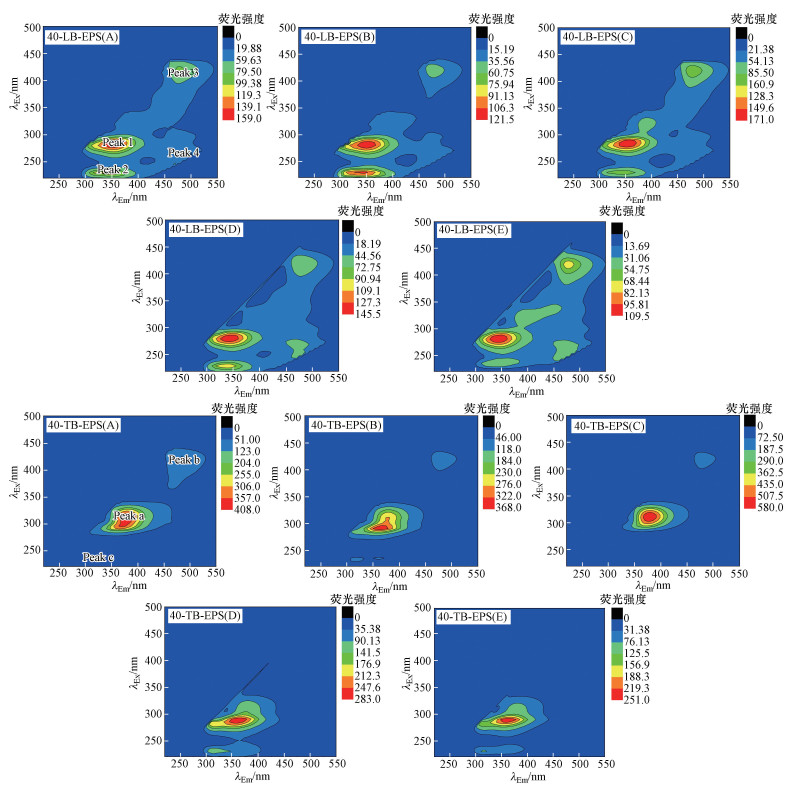 |
| 图 3 厌氧颗粒污泥EPS的三维荧光光谱图 Fig. 3EEM spectra of EPS in the anaerobic granular sludge |
由图 3可知, LB-EPS的荧光光谱出现了4个主要荧光峰, λEx/λEm为270~280 nm/340~360 nm时出现的峰1属于色氨酸蛋白物质, λEx/λEm为220~240 nm/320~360 nm时出现的峰2属于芳香族蛋白物质, λEx/λEm为420 nm/470 nm时出现的峰3属于辅酶F420物质, λEx/λEm为250~280 nm/450~480 nm时出现的峰4属于类腐殖酸物质(Zhu et al., 2015; 陆佳等, 2018).除在HA和1NA实验组中出现了峰4, 其余实验组和对照组的LB-EPS荧光峰位置基本一致, 这表明投加芳香酸后厌氧颗粒污泥的LB-EPS的成分和物理结构基本相似.在对照组A和实验组B、D中观察到荧光峰强度为峰1>峰2>峰3, 表明这两种蛋白类物质在生物聚集物中起着重要作用, 且BA和HA对这两种蛋白类物质影响不大.实验组D、E中出现腐殖酸物质荧光峰, 这可能与HA和1NA不易溶于水而附着于厌氧颗粒污泥有关, 且有报道称腐殖酸物质不利于污泥颗粒的形成和稳定性(Zhu et al., 2015).与LB-EPS相比, TB-EPS的EEM光谱较为简单, 出现了峰a色氨酸蛋白物质(λEx/λEm=270~280 nm/340~360 nm)、峰b辅酶F420物质(λEx/λEm=420 nm/470 nm)、峰c芳香族蛋白物质(λEx/λEm=220~240 nm/320~360 nm)的吸收峰.与对照组相比, 实验组C的a峰出现了红移, 实验组B、D和E的a峰位置在激发波长方面显示出10 nm的蓝移.红移与羰基、羟基和羧基等官能团的存在有关, 而蓝移则与大分子分裂成较小片段有关(Chen et al., 2002; ?wietlik et al., 2004).这表明TB-EPS与微生物细胞紧密连接且易于生物降解, 因此, 当微生物遭受毒性污染物的刺激时, EPS可能被用作能量来源, 导致一些简单物质或基团的产生(?wietlik et al., 2004; Zhu et al., 2015; 陆佳等, 2018).
3.4 芳香酸对关键酶活性的影响微生物的生物代谢与酶活性密切相关, 分析关键酶活性是评估微生物细胞活性的一种方法(Li et al., 2019).对于厌氧生物处理过程而言, 蛋白酶与蛋白质的水解有关, 乙酸激酶(AK)是产生乙酸的关键酶, 辅酶F420是产甲烷过程的关键酶(Zeng et al., 2019).因此, 本文分析了不同结构芳香酸对这3种酶的活性的影响, 结果如图 4所示.
图 4(Fig. 4)
 |
| 图 4 芳香酸对关键酶相对活性的影响 Fig. 4Effect of aromatic acid on the relative activities of key enzymes |
由图 4可知, 投加芳香酸的实验组AK相对活性顺序为BA>PA>1NA>HA, 其中, 含有HA、1NA的实验组AK相对活性分别比对照组减少了65.26%±1.673%、8.93%±1.915%, 相反, 含BA、PA的实验组AK活性分别增加了11.89%±0.313%、9.38%±1.439%, 可见HA和1NA会影响乙酸的生成.含有芳香酸的情况下, 厌氧颗粒污泥中蛋白酶活性均有所提高, 投加BA、PA、HA、1NA的实验组分别比对照组提高了39.80%±1.269%、33.73%±1.518%、70.95%±0.821%、35.46%±1.546%.蛋白酶负责蛋白质的分解并可发生酶促反应, 进而转换为微生物利用, 这也与3.3节含芳香酸的实验组EPS中PN含量较多相印证.相对于对照组, 厌氧颗粒污泥系统中加入这4种芳香酸后, 辅酶F420的活性均受到抑制, 尤其是BA与PA实验组, 辅酶F420的相对活性仅为33.23%±0.651%和22.90%±0.653%.由于辅酶F420是产甲烷细菌中特有的酶, 同时辅酶F420与厌氧污泥的产甲烷活性(SMA)具有明显的正相关(Dong et al., 2010), 从而说明BA、PA、HA、1NA均会降低产甲烷菌的活性.与水解细菌相比, 产甲烷菌对芳香酸的毒性更为敏感, 产甲烷过程将是厌氧生物处理含芳香酸废水的限制步骤.
3.5 芳香酸对厌氧颗粒污泥微生物群落的影响3.5.1 细菌群落结构与代谢通路分析厌氧颗粒污泥微生物群落主要包括细菌和古细菌, 两种菌群协同合作完成污染物的降解过程(Nakasaki et al., 2015).为考察不同结构芳香酸对厌氧颗粒污泥中微生物群落的影响, 根据16S rRNA的高通量测序数据, 评估了门水平下的细菌群落, 结果如图 5所示.
图 5(Fig. 5)
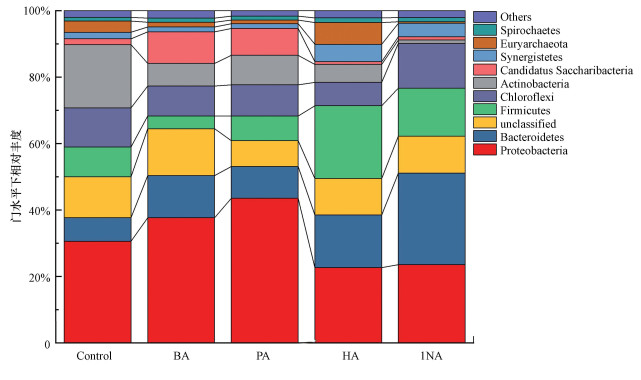 |
| 图 5 门水平下细菌群落丰度 Fig. 5Bacterial community structures and distribution at phylum level |
由图 5可知, Proteobacteria、Actinobacteria、Chloroflexi、Firmicutes和Bacteroidetes为厌氧颗粒污泥中的优势菌群.在对照组中优势菌的占比分别为Proteobacteria(30.6%)、Actinobacteria(18.99%)、Chloroflexi(11.77%)、Firmicutes(8.97%)和Bacteroidetes(7.1%).含有BA与PA实验组中Proteobacteria相对丰度比对照组提高了7.07%~12.93%, 而HA与1NA实验组中Proteobacteria相对丰度比对照组降低了7.04%~7.93%.Proteobacteria主要参与厌氧污泥发酵过程中乙酸、丙酸和丁酸的消耗, 这与上述HA、1NA实验组中AK含量较少有关, HA、1NA或会抑制Proteobacteria的生长从而抑制有机酸的产生(唐涛涛等, 2020).Bacteroidetes可参与降解大分子化合物, 这就解释了含有芳香酸的实验组中Bacteroidetes相对丰度比对照组增多了5.56%~20.43%(Biswal et al., 2020).Firmicutes所产生的水解酶和胞外酶与有机物的降解密切相关, 其在难降解有机物水解过程中发挥着重要作用(Yang et al., 2019).Chloroflexi可产生水解酶以降解可溶性微生物产物, 包括可溶性蛋白和可溶性多糖等, 其中投加了1NA的实验组中Chloroflexi相对丰度最高, 由此解释了其污泥EPS含量高于其他实验组的原因(Cheng et al., 2018).在含有芳香酸的实验组中Acidobacteria相对丰度皆小于对照组, 这表明芳香酸的加入使得Acidobacteria受到影响, Acidobacteria是丝状细菌, 对多环芳香烃、苯酚等难生物降解污染物具有一定的耐受性(Kim et al., 2008).
继而利用PICRUSt并根据高通量测序的KEGG数据来预测细菌代谢通路, 结果如图 6所示.图 6显示预测代谢通路分为4个主要类别:①代谢(总丰度:58.02%~58.79%);②遗传信息处理(总丰度:17.91%~19.79%);③环境信息处理(总丰度:17.30%~18.86%);④细胞过程(总丰度:4.47%~5.07%).氨基酸代谢和碳水化合物代谢这两个子功能显示出最高的丰度, 这表明厌氧颗粒污泥中微生物能够利用废水中的有机化合物进行新陈代谢(Huang et al., 2020).投加了芳香酸的实验组在氨基酸代谢这一功能中的相对丰度率略高于对照组, 氨基酸代谢是厌氧生物处理过程中水解的重要途径, 投加BA、PA、HA、1NA可增强与水解相关的途径.在遗传信息处理、环境信息处理和细胞过程功能范畴中, 复制与修复(7.68%~8.47%)、细胞膜转运(14.56%~15.84%)和细胞运动(3.46%~4.10%)这3个子功能较为丰富.
图 6(Fig. 6)
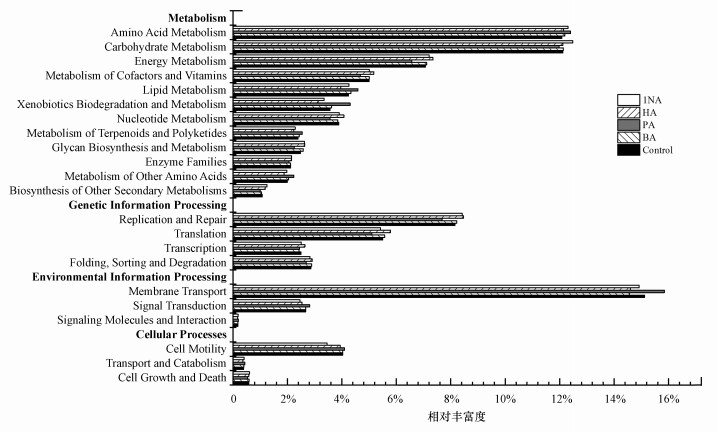 |
| 图 6 PICRUSt预测细菌群落的代谢通路 Fig. 6Metabolic pathway in bacterial community predicted by PICRUSt |
3.5.2 古细菌群落结构与代谢通路分析产甲烷阶段是厌氧消化的关键环节, 该阶段主要是由产甲烷菌完成, 因此, 本文分析了不同结构芳香酸对产甲烷菌群的影响, 结果如图 7所示(Koschorreck et al., 2010).
图 7(Fig. 7)
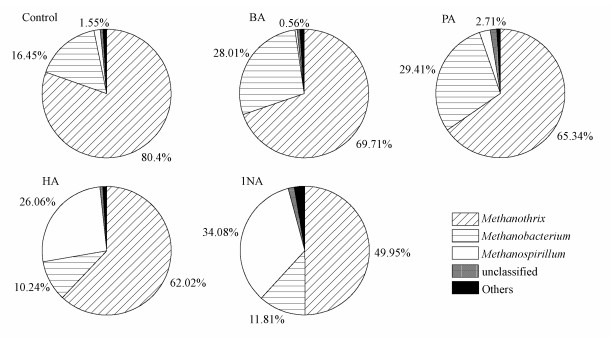 |
| 图 7 古细菌群落属水平上的相对丰度 Fig. 7Archaeal community relative abundance at genus level |
由图 7可知, 在厌氧颗粒污泥中, Methanothrix-乙酸型产甲烷菌为优势菌属, 其次为Methanobacterium-氢营养型产甲烷菌和Methanospirillum-氢营养型产甲烷菌.Methanothrix能够通过直接种间电子转移(DIET)接受电子, 将二氧化碳还原为甲烷(谭潇等, 2017).Methanobacterium、Methanospirillum属于氢营养型产甲烷, 主要与种间氢转移有关(Lin et al., 2019).Methanothrix在对照组中相对丰度达到80.4%, 但投加了HA、1NA芳香酸的实验组中Methanothrix相对丰度分别减少了18.38%和30.45%.有研究表明, Methanothrix从DIET中获得能量时, 其生长速度比以乙酸盐为唯一能源时要快, 由此推测芳香酸的特殊结构会抑制厌氧颗粒污泥中Methanothrix的DIET而减少能量的获取, 进而抑制甲烷的产生(Zhao et al., 2020).对照组中Methanobacterium和Methanospirillum的相对丰度分别为16.45%、1.55%.在含有BA、PA、HA、1NA的实验组中Methanobacterium的相对丰度分别为28.01%、29.41%、10.24%、11.81%, Methanospirillum的相对丰度分别为0.56%、2.71%、26.06%、34.08%.有****指出, BA、PA通过脱羧和氢营养型产甲烷菌的共同作用进行厌氧降解, 由此可知含有BA和PA的实验组中Methanobacterium相对丰度较对照组高(Liu et al., 2003).
本文对古细菌的代谢通路也进行了分析, 如图 8所示, 预测的代谢通路分为4个主要功能组:代谢(59.80%~61.35%)、遗传信息处理(24.89%~25.82%)、环境信息处理(11.92%~13.17%)和细胞过程(0.89%~2.20%).在代谢类别中, 基因丰度最高的是氨基酸代谢(13.12%~13.99%), 其次是能量代谢(12.19%~12.83%)和碳水化合物代谢(11.64%~12.21%).与对照组相比, 实验组的能量代谢丰度提高, 其中, 含有BA、PA的实验组能量代谢更丰富, 这在上一节SCOD的去除中也有所体现;实验组中氨基酸代谢、聚糖的生物合成与代谢、辅因子和维生素代谢能力降低, 尤为明显的是含有HA和1NA实验组的氨基酸代谢能力降低的更多, 这与芳香酸的结构不同有关.转化(10.38%~11.14%)、膜运输(10.85%~11.80%)、细胞运动(0.39~1.64%)是遗传信息处理、环境信息处理、细胞过程丰度最高的子功能途径, 尽管实验组中的微生物群落结构发生了变化, 但不同代谢途径的丰度差异不大.
图 8(Fig. 8)
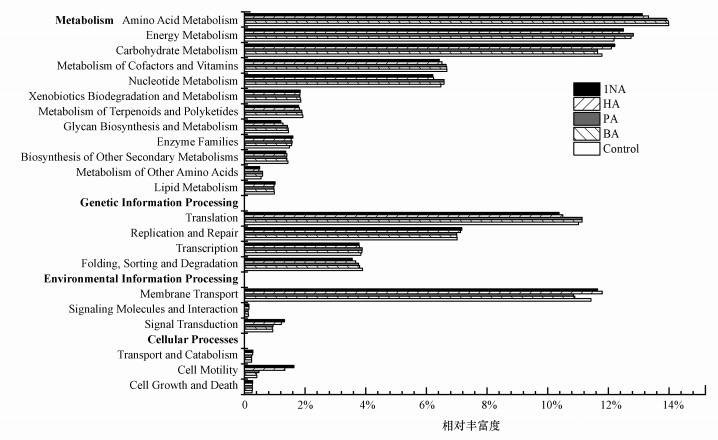 |
| 图 8 PICRUSt预测古细菌群落的代谢通路 Fig. 8Metabolic pathway in archaeal community predicted by PICRUSt |
4 结论(Conclusions)1) 加入BA、PA、HA及1NA后对厌氧颗粒污泥去除SCOD有一定的影响, 尤其是1NA实验组与对照组相比平均去除率降低了7%左右.含有芳香酸的实验组厌氧颗粒污泥EPS中PN、PS含量高于对照组.同时在EEM光谱中, HA和1NA实验组LB-EPS出现了腐殖酸物质的荧光峰.对于酶活性, 芳香酸的加入会抑制产甲烷菌的活性, 但提高了蛋白酶的活性.
2) 含有芳香酸的实验组中Bacteroidetes相对丰度增加, 而Acidobacteria相对丰度出现了降低, 1NA实验组体现的更为明显.乙酸型产甲烷菌Methanothrix为优势菌属, 同时BA与PA实验组Methanobacterium丰度较高, 而HA及1NA实验组Methanospirillum丰度较高.
3) 通过对比BA、PA、HA及1NA对厌氧颗粒污泥理化特性与微生物群落的影响发现, 芳香酸的加入对有机物的去除及微生物代谢通路预测未出现明显的抑制作用, 表明采用厌氧生物技术处理含芳香酸废水具有一定的潜力, 但芳香酸的存在使得厌氧颗粒污泥酶活性及古细菌的群落分布发生了变化, 可能会对厌氧生物处理的长期稳定运行造成一定影响.
参考文献
| American Public Health Association. 2012. Standard methods for the examination of water and wastewater[S]. Washington, DC: APHA |
| Baloch M I, Akunna J C, Kierans M, et al. 2008. Structural analysis of anaerobic granules in a phase separated reactor by electron microscopy[J]. Bioresource Technology, 99: 922-929. DOI:10.1016/j.biortech.2007.03.016 |
| Biswal B K, Wang B, Tang C, et al. 2020. Elucidating the effect of mixing technologies on dynamics of microbial communities and their correlations with granular sludge properties in a high-rate sulfidogenic anaerobic bioreactor for saline wastewater treatment[J]. Bioresource Technology, 297: 122397. DOI:10.1016/j.biortech.2019.122397 |
| Borah J M, Sarma J, Mahiuddin S. 2011. Influence of functional groups on the adsorption behaviour of substituted benzoic acids at the α-alumina/water interface[J]. Colloids and Surfaces A: Physicochemical and Engineering Aspects, 375: 42-49. |
| Chen J, Gu B, LeBoeuf E J, et al. 2002. Spectroscopic characterization of the structural and functional properties of natural organic matter fractions[J]. Chemosphere, 48: 59-68. DOI:10.1016/S0045-6535(02)00041-3 |
| Cheng C, Zhou Z, Qiu Z, et al. 2018. Enhancement of sludge reduction by ultrasonic pretreatment and packing carriers in the anaerobic side-stream reactor: Performance, sludge characteristics and microbial community structure[J]. Bioresource Technology, 249: 298-306. DOI:10.1016/j.biortech.2017.10.043 |
| Collado N, Buttiglieri G, Marti E, et al. 2013. Effects on activated sludge bacterial community exposed to sulfamethoxazole[J]. Chemosphere, 93: 99-106. DOI:10.1016/j.chemosphere.2013.04.094 |
| Dong F, Zhao Q B, Zhao J B, et al. 2010. Monitoring the restart-up of an upflow anaerobic sludge blanket (UASB) reactor for the treatment of a soybean processing wastewater[J]. Bioresource Technology, 101: 1722-1726. DOI:10.1016/j.biortech.2009.10.011 |
| Dong Y, Zhao J, Wang L, et al. 2019. Effect of bisphenol A and pentachlorophenol on different enzymes of activated sludge[J]. Science of the Total Environment, 671: 1170-1178. DOI:10.1016/j.scitotenv.2019.03.455 |
| Feng Y, Lu B, Jiang Y, et al. 2015. Performance evaluation of anaerobic fluidized bed reactors using brick beads and porous ceramics as support materials for treating terephthalic acid wastewater[J]. Desalination and Water Treatment, 53(7): 1814-1821. DOI:10.1080/19443994.2013.860628 |
| Guibaud G, Hullebusch E D, Bordas F, et al. 2009. Sorption of Cd(Ⅱ) and Pb(Ⅱ) by exopolymeric substances (EPS) extracted from activated sludges and pure bacterial strains: Modeling of the metal/ligand ratio effect and role of the mineral fraction[J]. Bioresource Technology, 100: 2959-2968. DOI:10.1016/j.biortech.2009.01.040 |
| Guo L, Lu M, Li Q, et al. 2014. Three-dimensional fluorescence excitation-emission matrix (EEM) spectroscopy with regional integration analysis for assessing waste sludge hydrolysis treated with multi-enzyme and thermophilic bacteria[J]. Bioresource Technology, 171: 22-28. DOI:10.1016/j.biortech.2014.08.025 |
| Guo X, Gu J, Gao H, et al. 2012. Effects of Cu on metabolisms and enzyme activities of microbial communities in the process of composting[J]. Bioresource Technology, 108: 140-148. DOI:10.1016/j.biortech.2011.12.087 |
| Hanna K, Lassabatere L, Béchet B. 2012. Transport of two naphthoic acids and salicylic acid in soil: Experimental study and empirical modeling[J]. Water Research, 46: 4457-4467. DOI:10.1016/j.watres.2012.04.037 |
| 胡学伟, 李姝, 荣烨, 等. 2014. Cu2+对生物膜及其胞外聚合物的影响[J]. 化工学报, 65(3): 1062-1067. DOI:10.3969/j.issn.0438-1157.2014.03.041 |
| Huang H, Biswal B K, Chen G, et al. 2020. Sulfidogenic anaerobic digestion of sulfate-laden waste activated sludge: Evaluation on reactor performance and dynamics of microbial community[J]. Bioresource Technology, 297: 122396. DOI:10.1016/j.biortech.2019.122396 |
| Kim Y H, Cha C J, Engesser K H, et al. 2008. Degradation of various alkyl ethers by alkyl ether-degrading Actinobacteria isolated from activated sludge of a mixed wastewater treatment[J]. Chemosphere, 73: 1442-1447. DOI:10.1016/j.chemosphere.2008.07.074 |
| Kong Z, Li L, Xue Y, et al. 2019. Challenges and prospects for the anaerobic treatment of chemical-industrial organic wastewater: A review[J]. Journal of Cleaner Production, 231: 913-927. DOI:10.1016/j.jclepro.2019.05.233 |
| Koschorreck M, Geller W, Neu T, et al. 2010. Structure and function of the microbial community in an in situ reactor to treat an acidic mine pit lake[J]. FEMS Microbiology Ecology, 73: 385-395. |
| Lee Y, Han G. 2016. Application of sequential expanded granular sludge bed reactors for biodegradation of acetate, benzoate, terephtalate andp-toluate in purified terephtalic acid production wastewater[J]. Environmental Technology, 37(9): 1141-1150. DOI:10.1080/09593330.2015.1102973 |
| Li B L, Yan W K, Wang Y, et al. 2019. Effects of key enzyme activities and microbial communities in a flocculentgranular hybrid complete autotrophic nitrogen removal over nitrite reactor under mainstream conditions[J]. Bioresource Technology, 280: 136-142. DOI:10.1016/j.biortech.2019.01.146 |
| Liu C, Wachemo A C, Tong H, et al. 2018. Biogas production and microbial community properties during anaerobic digestion of corn stover at different temperatures[J]. Bioresource Technology, 261: 93-103. DOI:10.1016/j.biortech.2017.12.076 |
| Lin C, Wu P, Liu Y, et al. 2019. Enhanced biogas production and biodegradation of phenanthrene in wastewater sludge treated anaerobic digestion reactors fitted with a bioelectrode system[J]. Chemical Engineering Journal, 365: 1-9. DOI:10.1016/j.cej.2019.02.027 |
| Liu S, Chi W. 2003. CO2-H2-dependent anaerobic biotransformation of phthalic acid isomers in sediment slurries[J]. Chemosphere, 52: 951-958. DOI:10.1016/S0045-6535(03)00326-6 |
| 陆佳, 刘永军, 刘喆, 等. 2018. 有机负荷对污泥胞外聚合物分泌特性及颗粒形成的影响[J]. 化工进展, 37(4): 1616-1622. |
| 马凯丽. 2017. PTA废水生物处理工艺的运行效能及微生物群落结构特征研究[D]. 哈尔滨: 哈尔滨工业大学 |
| Ma X, Li X, Wang X, et al. 2020. Impact of salinity on anaerobic microbial community structure in high organic loading purified terephthalic acid wastewater treatment system[J]. Journal of Hazardous Materials, 383: 121132. DOI:10.1016/j.jhazmat.2019.121132 |
| 马小云, 万金泉. 2011. 苯酚对厌氧颗粒污泥的毒性研究[J]. 环境科学, 32(5): 1402-1406. |
| Ma K, Zhao X, Shang Y, et al. 2020. Improved purified terephthalic acid wastewater treatment using combined UAFB-SBR system: At mesophilic and ambient temperature[J]. Chemosphere, 247: 125752. DOI:10.1016/j.chemosphere.2019.125752 |
| Martín V M J, Sáez C, Pérez J F, et al. 2017. Irradiated-assisted electrochemical processes for the removal of persistent pollutants from real wastewater[J]. Separation and Purification Technology, 175: 428-434. DOI:10.1016/j.seppur.2016.11.014 |
| Mu H, Chen Y, Xiao N. 2011. Effects of metal oxide nanoparticles (TiO2, Al2O3, SiO2 and ZnO) on waste activated sludge anaerobic digestion[J]. Bioresource Technology, 102: 10305-10311. DOI:10.1016/j.biortech.2011.08.100 |
| Nakasaki K, Kwon S H, Takemoto Y, et al. 2015. An interesting correlation between methane production rates and archaea cell density during anaerobic digestion with increasing organic loading[J]. Biomass Bioenergy, 78: 17-24. DOI:10.1016/j.biombioe.2015.04.004 |
| Qian J, Li K, Wang P, et al. 2017. Toxic effects of three crystalline phases of TiO2 nanoparticles on extracellular polymeric substances in freshwater biofilms[J]. Bioresource Technology, 241: 276-283. DOI:10.1016/j.biortech.2017.05.121 |
| Sennaoui A, Alahiane S, Sakr F, et al. 2019. Comparative degradation of benzoic acid and its hydroxylated derivatives by electro-Fenton technology using BDD/carbon-felt cells[J]. Journal of Environmental Chemical Engineering, 7: 103033. DOI:10.1016/j.jece.2019.103033 |
| Srisowmeya G, Chakravarthy M, Nandhini D G. 2020. Critical considerations in two-stage anaerobic digestion of food waste-A review[J]. Renewable and Sustainable Energy Reviews, 119: 109587. DOI:10.1016/j.rser.2019.109587 |
| Sun L, Wan S, Yu Z, et al. 2012. Anaerobic biological treatment of high strength cassava starch wastewater in a new type up-flow multistage anaerobic reactor[J]. Bioresource Technology, 104: 280-288. DOI:10.1016/j.biortech.2011.11.070 |
| ?wietlik J, Dabrowska A, Raczyk-Stanis?awiak U, et al. 2004. Reactivity of natural organic matter fractions with chlorine dioxide and ozone[J]. Water Research, 38: 547-558. DOI:10.1016/j.watres.2003.10.034 |
| 唐涛涛, 李江, 杨钊, 等. 2020. 污泥厌氧消化功能微生物群落结构的研究进展[J]. 化工进展, 39(1): 320-328. |
| 谭潇, 黄靓, 杨平, 等. 2017. 盐度对EGSB反应器的运行及厌氧颗粒污泥的影响[J]. 环境科学, 38(8): 3422-3428. |
| Wang B, Shi X, Liu X, et al. 2019. Insight into the Fenton-induced degradation process of extracellular polymeric substances (EPS) extracted from activated sludge[J]. Chemosphere, 234: 318-327. DOI:10.1016/j.chemosphere.2019.06.078 |
| Wu L, Li B, Liu M. 2018. Influence of aromatic structure and substitution of carboxyl groups of aromatic acids on their sorption to biochars[J]. Chemosphere, 210: 239-246. DOI:10.1016/j.chemosphere.2018.07.003 |
| Yang G, Wang J, Zhang H, et al. 2019. Applying bio-electric field of microbial fuel cell-upflow anaerobic sludge blanket reactor catalyzed blast furnace dusting ash for promoting anaerobic digestion[J]. Water Research, 149: 215-224. DOI:10.1016/j.watres.2018.10.091 |
| Zeng T, Rene E R, Zhang S, et al. 2019. Removal of selenate and cadmium by anaerobic granular sludge: EPS characterization and microbial community analysis[J]. Process Safety and Environmental Protection, 126: 150-159. DOI:10.1016/j.psep.2019.03.039 |
| 张金龙, 李霄云, 包万鸿, 等. 2018. 邻苯二甲酸和苯甲酸在功能化碳纳米管上的吸附行为[J]. 中国环境科学, 38(11): 4106-4113. DOI:10.3969/j.issn.1000-6923.2018.11.015 |
| Zhang Y, Ma H, Niu Q, et al. 2016. Effects of soluble microbial products (SMP) on the performance of an anammox attached film expanded bed (AAFEB) reactor: synergistic interaction and toxic shock[J]. Bioresource Technology, 222: 261-269. DOI:10.1016/j.biortech.2016.09.129 |
| Zhao J, Li Y, Chen X, et al. 2018. Effects of carbon sources on sludge performance and microbial community for 4-chlorophenol wastewater treatment in sequencing batch reactors[J]. Bioresource Technology, 255: 22-28. DOI:10.1016/j.biortech.2018.01.106 |
| Zhao Z, Wang J, Yang L, et al. 2020. Why do DIETers like drinking: Metagenomic analysis for methane and energy metabolism during anaerobic digestion with ethanol[J]. Water Research, 171: 115425. DOI:10.1016/j.watres.2019.115425 |
| 钟中, 杨忠林, 吕效平, 等. 2013. 冲击负荷对厌氧折流板反应器运行性能的影响[J]. 南京工业大学学报, 35(2): 103-106. DOI:10.3969/j.issn.1671-7627.2013.02.021 |
| Zhu L, Zhou J, Lv M, et al. 2015. Specific component comparison of extracellular polymeric substances (EPS) in flocs and granular sludge using EEM and SDS-PAGE[J]. Chemosphere, 161: 26-32. |
